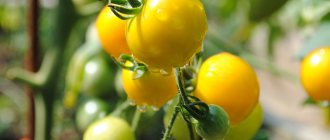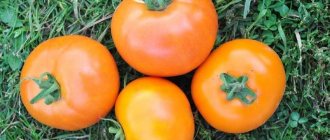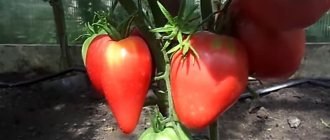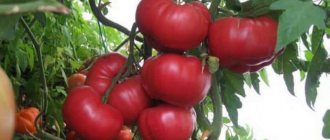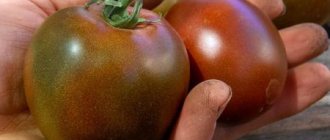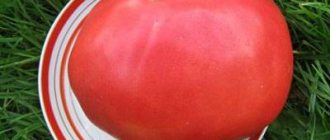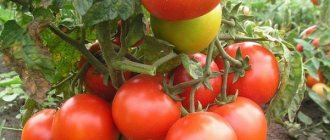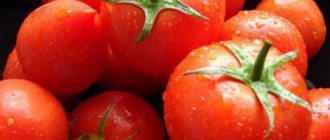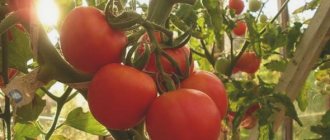Andromeda F1 red
The hybrid was included in the register of breeding achievements in 1998. Its originator is breeder Alexey Alekseevich Mashtakov. Tomato is recommended for cultivation in the following areas:
- East Siberian;
- West Siberian;
- Nizhnevolzhskaya;
- Srednevolzhskaya;
- North Caucasus;
- Central black earth.
The hybrid forms a low-growing bush that does not exceed 0.5-0.7 m in height. Despite its short stature, the plant does not belong to the standard variety.
Forms a semi-spreading bush that needs additional support. Removing excess stepsons is recommended, but not required.
The tomato has medium branching and foliage. The leaves are medium corrugated, gray-green in color.
The inflorescence of Andromeda is simple, intermediate. The first ovaries are formed above the 6-7th leaf, the subsequent ones - every 1-2 leaves. The hybrid has a jointed peduncle.
Andromeda tomatoes, a classic red color, have flat-round fruits with smooth skin. The weight of one tomato ranges from 75 to 125 g, the number of chambers varies from 4 to 5.
The ripening period depends on the region and ranges from 89 to 118 days after complete germination of seedlings. The yield of a hybrid is also greatly influenced by the terrain and conditions in which it is grown. The average figures declared by the originator are 8-10 kg per square meter. m.
Tomato Andromeda F1 is very similar in characteristics and description to the Early 83 variety, which gardeners love so much. However, the latter loses in terms of yield: the indicators are at the level of 6 kg per square meter. m.
Andromeda is a salad hybrid. The fruits are also ideal for winter harvesting, thanks to their durable skin that is not prone to cracking.
Description
Experienced gardeners will always pay attention to its characteristics before giving preference to one variety or another. So, when choosing a variety of Andromeda tomatoes, study the description of this variety. This tomato is today one of the most popular and widespread vegetables in our country. True gardeners, in order to get a ripe, juicy fruit, will need a lot of time and skillful hands. When choosing seedlings for planting, first of all they pay attention to first-class tomatoes, one of these is the Andromeda tomato variety.
Stages of development
The Andromeda tomato variety grows up to a certain point. Development stops when a sufficient number of 4-5 brushes are formed on the bush.
The hybrid subspecies Andromeda F1 in greenhouse conditions grows to a height of 1 m. If the Andromeda tomato bush is grown outdoors, the height will be a maximum of 60-70cm in height. The branching capacity of the variety is average.
External features
The foliage of Andromeda f1 golden has a light shade. The Andromeda golden fox tomato has an emerald-silver hue. The tomato inflorescence is simple. But it can have an average of 5-7 fruits. The first inflorescence appears on the 6th leaf, then every other one.
The Andromeda tomato comes in three colors: red, pink, yellow. The fruit has a smooth surface, round and slightly flattened shape. Tomato variety Andromeda f1 is quite dense and has an even color.
Fruit weight
The weight of the variety depends on the subspecies. Basically, the average weight of the fruit is 70-140g. The Golden Andromeda tomato is large, its weight is 100-140g. The Pink Andromeda tomato weighs 90-120g. But among these fruits there were also tomatoes that weighed 300-320g.
The Andromeda hybrid has a very good yield, 9-10 kg per square meter, depending on the subspecies. In a good season, the harvest can exceed 12 kg.
Tomato pink Andromeda F1
Culture is included in the State Register for the North Caucasus region. The originator of the hybrid is also Alexey Mashkov. The first harvest is harvested 90 days after sowing.
Unlike the red Andromeda, the pink one may have slightly smaller fruits. The weight of one tomato is about 60-89 g.
The tomatoes are flat-round in shape with barely pronounced ribbing; when fully ripe, they acquire a crimson color. The tomato pulp is dense, juicy with 4-6 nests.
Pink fruits, unlike red ones, may contain slightly more sugars when fully ripe. Due to this, raspberry tomatoes of this hybrid are recognized as more harmonious in terms of sourness and sweetness.
When grown in film greenhouses, the yield per sq. m can reach up to 13 kg. At the end, up to 96% of the fruits from the total harvest retain their marketable appearance.
Pink Andromeda tomatoes are positioned by the manufacturer as heat-resistant.
Tomato golden Andromeda F1
The orange hybrid, like its close “relatives,” is included in the State Register. Recommended for cultivation in unprotected beds in the North Caucasus region.
The ripening dates declared by the originator range from 77 to 115 days after the appearance of full shoots.
A low-growing bush lays the first inflorescence above the 5th or 6th leaf, the subsequent ones every 1-2.
Golden Andromeda tomatoes are round and slightly flattened, with slight ribbing at the stalk. The fruits weigh from 64 to 100 g. Fully ripened tomatoes have a rich orange color.
In terms of taste, golden Andromeda is sweeter than the pink and red varieties. The pulp of this hybrid accumulates more sugars, which amount to 3.2% as a percentage. For a red hybrid, these figures average 2%, for a pink hybrid – 2.2%.
Like all varieties of Andromeda, the orange fruits are endowed with dense skin, due to which the tomato has good transportability.
The pulp of the hybrid is dense, tasty, with pronounced tomato sourness. The number of nests is from 4 or more.
Ripe tomatoes can be eaten fresh, prepared in salads and used for preservation.
Features of growing through seedlings
The recommended time for sowing Andromeda by the manufacturer is the last ten days of March or the first days of April.
Before planting, seeds are soaked in Fitosporin solution for 1-2 hours. The same drug is spilled on the ground. Disinfection of planting material and soil will help avoid fungal diseases of tomatoes at the stage of growing seedlings.
Andromeda is planted according to the standard scheme: the distance between the seeds and grooves is 1-2 cm, the planting depth is 1-1.5 cm.
The crops are covered with film or glass and put in a warm place. After the first seedlings peck, the shelter is removed and the seedling containers are placed closer to the windows. If the windows do not face the sunny side, the tomatoes will have to be illuminated.
Picking seedlings can begin after the first true leaf appears. 2 weeks after planting, the tomatoes are fed with specialized fertilizers with a high nitrogen content.
2 weeks before moving to open or closed ground, seedlings must undergo adaptation to new conditions. Plants are taken outside, veranda or greenhouse, first for a few minutes, then gradually increase the time. The seedlings spend the last 24 hours in conditions as close as possible to those in which they will be grown.
Andromeda hybrid seedlings are ready for transplanting into film greenhouses from mid-May. Plants are moved to open ground at the end of May or beginning of June. By this time, the seedlings should be 60-65 days old, and each bush should have 5-6 true leaves.
Planting seedlings
Growing Andromeda begins with planting seeds to produce young seedlings.
See also
Characteristics and description of the tomato variety FlashRead
Seed preparation
First, the planting material is disinfected. During this procedure, you can use a special mixture of boric acid and vitriol. There are also other ways in which seeds can be disinfected. To do this, you can soak them in a weak solution of potassium permanganate. The seeds should be soaked in it for thirty minutes, after which they are washed and dried.
Soil preparation
It is recommended to plant the Pink Andromeda tomato in pre-heated soil. Its temperature should be at least 15 degrees Celsius. You don't have to wait for warm weather for the earth to warm up. You can raise its temperature yourself. To do this, just pour hot, boiled water over it several times. In this way, you can not only warm the soil well, but also disinfect it.
Also, during cultivation, you can install a floor fan, which will warm the air and prevent the soil from cooling down.
Disembarkation
Seeds are planted in pre-prepared containers. Most often, low boxes or peat pots are used for this. The second option is even better, since you can plant the plant together with the same pots.
Several tomato seeds are placed in each pot at a distance of 5-10 mm. The planting depth should not be too deep. It will be enough to deepen the seeds a few millimeters under the soil. After planting, containers with tomatoes are placed in a warm and well-lit place.
Planting in the ground and further care
The planting pattern recommended by the manufacturer is 50 by 40 cm. When planting in open ground in cold regions, film shelters may be needed for the first time.
The central stem and side shoots need garter. Therefore, when planting, a support is installed next to each bush.
To obtain a rich harvest and larger fruits, Andromeda is planted with stepsons. The procedure is first performed 2 weeks after transplantation.
The hybrid responds well to feeding. After planting in the ground, 2-3 weeks later, the plants can be fertilized with a mineral complex with a high nitrogen content.
After the second flower cluster extends, the crop needs potassium and phosphorus. During the flowering period, the tomato can be watered at the root or sprayed with boric acid.
Be sure to prevent fungal diseases. Gardeners consider Fitosporin to be one of the best drugs for preventing late blight.
Tomato care
Stepsoning
Tomatoes need staking to supports
In greenhouse conditions, tomato bushes need to be tied up and pinched. The bush is formed from 2 stems.
You can trim the plant using scissors. Before use, as well as after processing the first bush, the instrument is disinfected so that the possible infection does not spread.
The best time for the procedure is morning. It is carried out 2 times a week.
It is recommended to sprinkle ash on plant cuts to prevent infectious agents from getting into open wounds.
It is worth pruning healthy bushes first, and then those with brown or wilted leaves. If another one breaks through in place of the cut stepson, it also needs to be cut off. Always inspect each plant carefully.
It is necessary to regularly trim the leaves of the lower tier.
You can remove no more than 3 leaves per week, otherwise the growth of the bush will be slowed down. It is forbidden to pull the leaves to the bottom, as this may cause the stem bark to break. Break off the leaves, moving to the side.
Spraying and fertilizing
During the warm season, additional spraying is carried out. This is done in the morning or in the evening.
- According to the description, pink Andromeda has a weak root system, so the bushes need to be regularly watered and fed (mineral fertilizers are especially suitable).
- Tomato Golden Andromeda F1 loves moisture, because of this it is worth watering them constantly, monitoring the normal level of soil moisture. After watering, loosening is carried out. Fertilizers need to be applied at least 3 times. It would be correct to feed the crop with ash (10 g per 1 liter of water).
The stepson that grows into the first inflorescence is left behind. The following stepsons need to be trimmed. If the bush grows too much, the harvest will be poor.
Due to a poorly developed root system, tomatoes do not always have enough microelements and nutrients. This requires frequent and additional feeding. The first time it should be done when the first brush is laid. Only 30 g of solution is used per m². Use organic products:
- iodine;
- yeast;
- alcohol;
- ash;
- boric acid;
- hydrogen peroxide.
Before feeding the soil, water it with water at medium temperature (1 liter for each bush). Moistening is carried out as necessary when the soil dries out. During hot periods, the frequency should be increased. To retain sufficient moisture, mulching is carried out.
Susceptibility to diseases and pests
Like most nightshades, the Andromeda F1 hybrid is not 100% disease resistant. The red variety is more susceptible to late blight and macrosporiosis than others.
Golden Andromeda is resistant to TMV, pink - to tobacco mosaic virus and Alternaria.
In open and closed ground, the hybrid can be attacked by whiteflies, aphids and other pests. In the greenhouse, Andromeda is more susceptible to spider mites.
At the first signs of pest damage, treatment is carried out with insectoacaricidal preparations.
Advantages and disadvantages
When talking about something, one cannot lose sight of such criteria as advantages and disadvantages.
Advantages can include:
- Early ripeness
- Resistance to frost and sudden changes in weather conditions
- Excellent taste
- Unpretentiousness
- Maturation by brushes
The disadvantages include:
- Weak root system
- The need for constant additional feeding
- Susceptibility to late blight
But according to many, the quality and taste of the fruit far outweigh the several drawbacks.
Similar varieties
Red Andromeda tomatoes are similar in description and characteristics to other early ripening cultivars:
- Agata - suitable for open ground and film greenhouses. Ripens 100-110 days after full germination. Flat-round tomatoes weigh on average 100 g. The plant forms a low bush, not exceeding 45 cm.
- Nepryadva - ripens 99-112 days after the appearance of seedlings. The type of bush is similar to Andromeda, but unlike the latter it does not exceed 40 cm in height. Red fruits weigh up to 90 g. It has high yields and good taste.
- Generosity - suitable for growing without seedlings. Forms round, bright red fruits with dense skin weighing 80 g. Productivity per 1 sq. m. reaches 10 kg.
